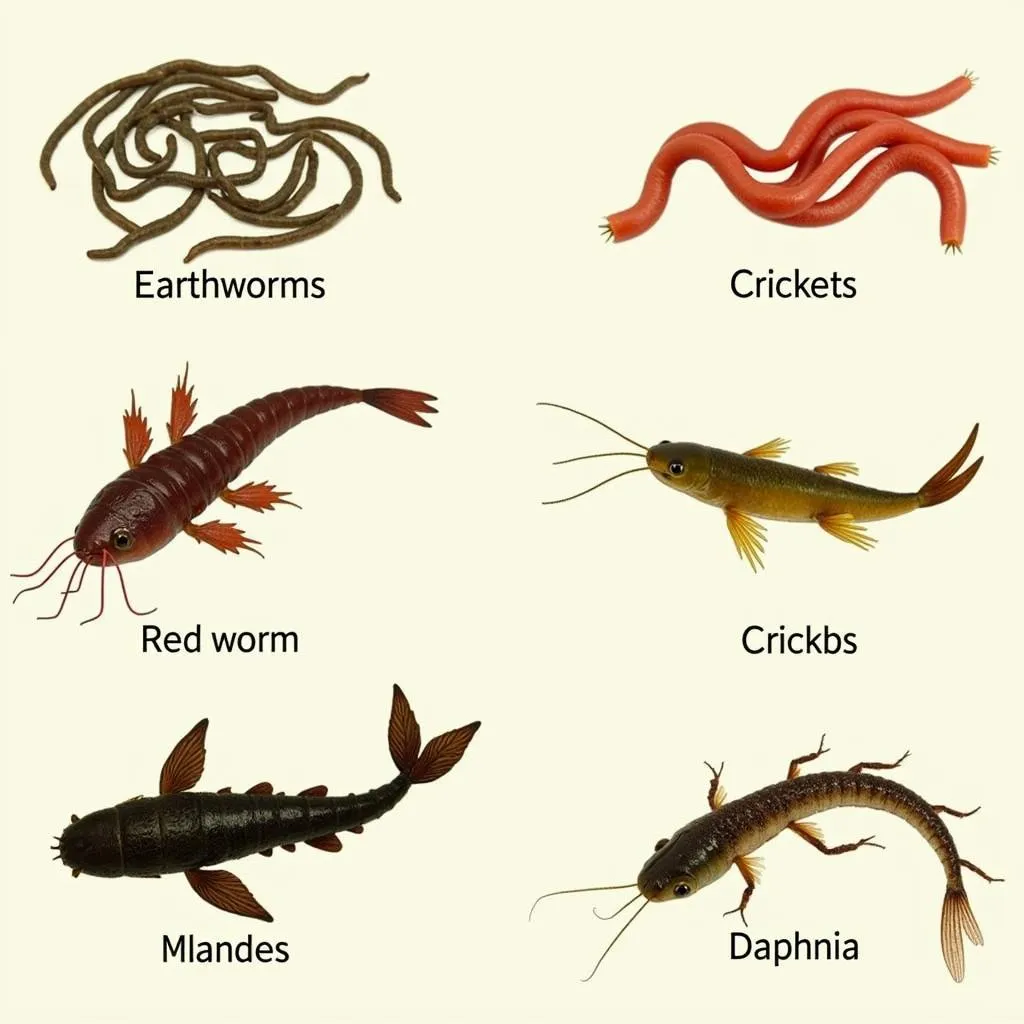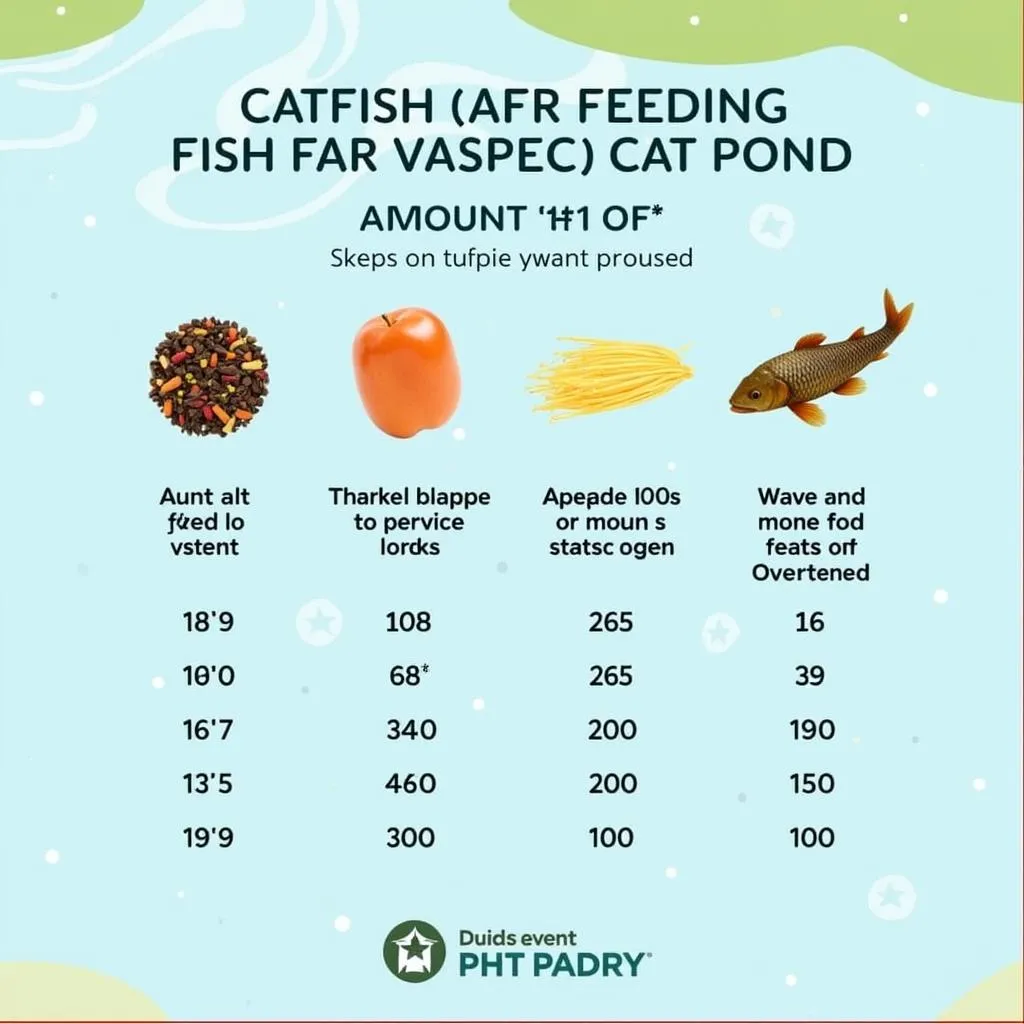This comprehensive guide will help you understand the best Catfish Food For Pond, offering expert tips and advice on feeding your catfish for optimal growth and health.
Catfish are fascinating creatures that can thrive in a variety of pond environments. Feeding them the right food is essential to their well-being. This article explores the different types of catfish food, how to choose the right option, and how to create a balanced feeding regimen for your pond.
Understanding Catfish Dietary Needs
Before diving into the specifics of catfish food, it’s crucial to understand their dietary requirements. Catfish are omnivores, meaning they eat both plants and animals. In their natural habitat, they feed on a variety of organisms like:
- Insects: Catfish are known to be voracious insect eaters, particularly during their juvenile stages.
- Crustaceans: These include small crabs, shrimp, and crayfish.
- Worms: Earthworms and other types of worms are a staple food source.
- Algae: They also consume algae and other aquatic plants.
- Small fish: Larger catfish may occasionally prey on smaller fish.
The Best Catfish Food for Pond: A Comprehensive Review
The optimal catfish food for your pond depends on various factors, including the size and age of your catfish, the water conditions, and your desired growth rate. Here’s a detailed review of the common types of catfish food:
1. Commercial Catfish Pellets
Commercial catfish pellets are widely available and a convenient option for feeding. These pellets are designed to meet the specific nutritional needs of catfish, offering a balanced blend of protein, carbohydrates, fats, vitamins, and minerals. They are typically made from ingredients like:
- Fish meal: A high-quality protein source derived from fish processing.
- Soybean meal: A rich source of protein and essential amino acids.
- Corn meal: Provides carbohydrates for energy.
- Wheat middlings: Another source of carbohydrates and fiber.
- Fish oil: A source of omega-3 fatty acids.
**Pros:**
- Convenience: Easily available and simple to use.
- Nutrient-dense: Contain a balanced blend of essential nutrients.
- Controlled feeding: Allows for precise control of food intake.
- Sinking: Sinks to the bottom, preventing surface water pollution.
**Cons:**
- Can pollute the pond: Excess pellets can lead to water quality issues if not properly consumed.
- Less natural: Lack the variety and natural elements found in live foods.
- May attract unwanted pests: Pellets can attract other fish and wildlife to the pond.
2. Live Food for Catfish
Live food offers a more natural and nutritious option for catfish. It’s closer to their natural diet and promotes a healthier, more active fish. Here are some common live food choices:
- Worms: Earthworms, red worms, and blackworms are excellent sources of protein and nutrients.
- Insects: Grubs, crickets, and mealworms provide a good source of protein.
- Daphnia: A type of zooplankton rich in protein and essential fatty acids.
- Small fish: For larger catfish, small fish like minnows can be a suitable food source.
**Pros:**
- Natural diet: Mimics their natural feeding habits.
- High nutritional value: Provides a wide range of essential nutrients.
- Encourages natural behaviors: Stimulates foraging instincts.
**Cons:**
- Requires effort: May require additional effort to cultivate and collect live food.
- Storage challenges: Live food may be challenging to store and maintain.
- Cost: Can be more expensive than commercial pellets.
 Live food options for catfish in pond
Live food options for catfish in pond
3. DIY Catfish Food Recipes
For those who want to create their own custom catfish food, there are several DIY recipes available online. These recipes often use readily available ingredients like:
- Fish meal: A basic ingredient for providing protein.
- Soybean meal: Adds protein and essential amino acids.
- Corn meal: Provides energy and carbohydrates.
- Wheat middlings: Provides fiber and additional nutrients.
- Vitamins and minerals: Essential supplements for overall health.
**Pros:**
- Customization: Allows you to tailor the recipe to your catfish’s specific needs.
- Cost-effective: Can be less expensive than commercial options.
- Control over ingredients: Provides complete control over the ingredients and quality.
**Cons:**
- Time-consuming: Requires time and effort to prepare.
- Consistency: Can be challenging to maintain consistency in quality and nutritional value.
- Storage: May need to be stored properly to prevent spoilage.
Choosing the Right Catfish Food for Your Pond
The choice of catfish food depends on several factors, including:
- Catfish age and size: Juvenile catfish need higher protein levels than mature catfish.
- Water conditions: The water quality and temperature can impact the type of food suitable for your catfish.
- Budget: Live food can be more expensive than commercial pellets.
- Time commitment: Cultivating and collecting live food requires additional time and effort.
Here’s a quick guide:
- For juvenile catfish: Choose high-protein commercial pellets or live food like worms and insects.
- For mature catfish: You can use lower-protein commercial pellets or a combination of pellets and live food.
Always remember to introduce new foods gradually to avoid upsetting your catfish’s digestive system.
Feeding Your Catfish: How Much and How Often
Overfeeding can lead to water pollution and health problems for your catfish. Here are some tips for feeding your catfish:
- Feed them in the morning: Catfish are more active in the morning and will readily consume their food.
- Feed them a small amount: Start with a small amount of food and increase it gradually until you find the right balance.
- Observe their feeding behavior: Watch your catfish to see if they are consuming all the food within a few minutes. If they are leaving food behind, reduce the amount.
- Adjust the feeding schedule: Feed your catfish more often when they are growing rapidly.
 Feeding schedule for catfish in pond
Feeding schedule for catfish in pond
Tips for Maintaining Healthy Catfish
- Monitor water quality: Regularly test your pond’s water quality to ensure it’s suitable for your catfish.
- Provide hiding spots: Catfish are shy creatures and need hiding places to feel safe and secure.
- Add vegetation: Aquatic plants can provide shelter and food for your catfish.
- Control parasites: Use appropriate treatments to control any parasites or diseases that might affect your catfish.
Expert Insights: Feeding Catfish in the Pond
Dr. Alice Brown, a renowned fish biologist, states:
“It’s important to remember that catfish are adaptable eaters and can thrive on a variety of food sources. Providing a balanced diet is essential for their growth and overall health.”
John Smith, a veteran catfish farmer, shares his perspective:
“While commercial catfish pellets are convenient, I find that supplementing their diet with live food like worms and insects helps them grow faster and stay healthy.”
Frequently Asked Questions (FAQ)
1. Can I feed catfish bread crumbs?
While bread crumbs are not harmful, they lack the essential nutrients that catfish require. It’s best to avoid feeding them bread crumbs.
2. Can I overfeed my catfish?
Overfeeding can lead to excess waste, water pollution, and health problems for your catfish. It’s crucial to feed them only what they can consume within a few minutes.
3. What should I do if my catfish are not eating?
If your catfish are not eating, check for any signs of illness or parasites. You can also try offering them a variety of foods to stimulate their appetite.
4. How often should I change the water in my pond?
The frequency of water changes depends on the size of your pond and the number of catfish you have. Aim for at least a partial water change every few weeks.
5. Can I keep other fish with my catfish?
Some fish species can coexist peacefully with catfish, but it’s essential to research the compatibility of different fish before introducing them to your pond.
Conclusion
Choosing the right catfish food for your pond is essential for their growth and overall health. Whether you opt for commercial pellets, live food, or a combination of both, remember to consider your catfish’s age, water conditions, and your budget. By following these guidelines and providing a healthy and balanced diet, you can enjoy watching your catfish thrive in your pond for years to come.
Remember: Always research the specific needs of your catfish and seek professional advice if you have any concerns.